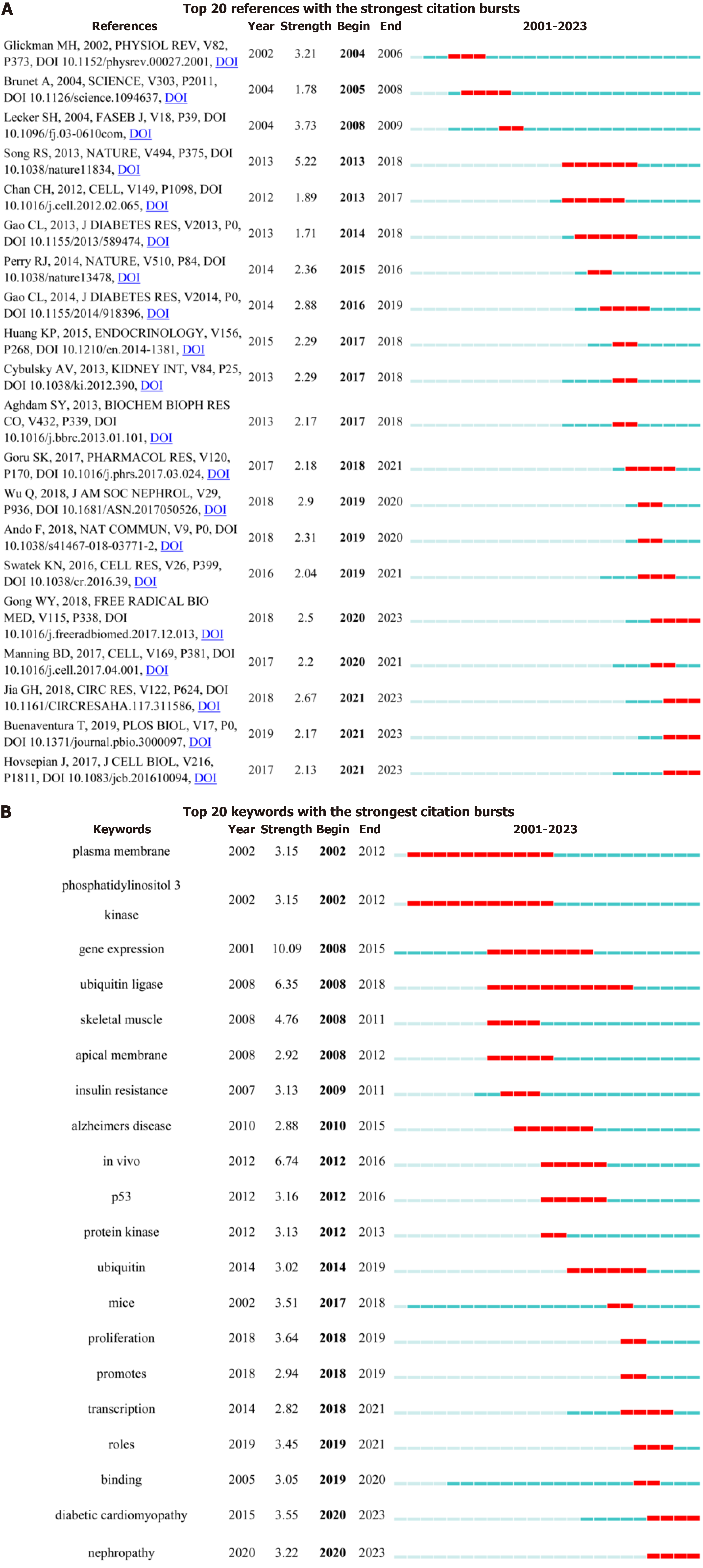Copyright
©The Author(s) 2025.
World J Diabetes. Jan 15, 2025; 16(1): 100099
Published online Jan 15, 2025. doi: 10.4239/wjd.v16.i1.100099
Published online Jan 15, 2025. doi: 10.4239/wjd.v16.i1.100099
Figure 1 Literature screening process and bibliometric analysis methods.
Figure 2 Annual publication trends in diabetes ubiquitination research, with the year of publication in the horizontal coordinate and the number of publications in the vertical coordinate.
Figure 3 Visualization of country collaboration analysis for diabetes ubiquitination studies.
Nodes represent countries, with the size of each node proportional to the number of articles published by that country, and the thickness of the connecting lines proportional to the intensity of collaboration between countries. Nodes with a purple periphery indicate high centrality, and nodes of different colors represent different publication years.
Figure 4 Visualization of institutional research in diabetes ubiquitination studies.
A: Visualization of institutional collaboration analysis. Only institutions with at least ten publications are shown in the figure. Each node represents an institution, with the size of the node proportional to the number of articles published by that institution, and the thickness of the connecting lines proportional to the intensity of collaboration between institutions. Nodes with a purple periphery indicate high centrality, and nodes of different colors represent different publication years; B: Top ten keywords clustering analysis of institutional research themes. The text with different numbers indicates the keyword clusters of these institutions, each node represents one institution, and different colors represent different clusters.
Figure 5 Visualization of co-cited authors and journals research in diabetes ubiquitination studies.
A: Top ten keyword clustering analysis for co-cited author research topics. Each cluster shows only the most influential authors. The text with different numbers indicates the keyword clusters for these co-cited author research topics. Each node represents an author, and different colors represent different clusters; B: A double overlay figure showing journals with research related to diabetes ubiquitination, with citing journals on the left and cited journals on the right. Labels indicate disciplines, and links indicate citation paths.
Figure 6 Top 20 references and keywords with the strongest bursts.
A: Top 20 references with the strongest bursts in the diabetes ubiquitination study; B: Top 20 keywords with the strongest bursts in the diabetes ubiquitination study.
Figure 7 Visualization of keywords in diabetes ubiquitination studies.
A: Visualization of the co-occurrence analysis of keywords in diabetes ubiquitination research. Only keywords with a frequency of 6 or more occurrences are shown. Each node represents a keyword, and the size of the node is proportional to its frequency. The thickness of the connecting lines indicates how frequently two keywords co-occur, and different colors represent the years the keywords appeared; B: Timeline visualization of the top ten keywords clustering analysis. Keywords on the same line correspond to the clusters on the right. Each node represents a keyword, and the size of the node is proportional to its frequency. The position of the node on the horizontal axis indicates the keyword's first occurrence; C: Timeline visualization of keywords. Each node represents a keyword, and its size is proportional to the frequency of the keyword. The position of the node on the horizontal axis indicates the time of the keyword's first appearance.
- Citation: Xiong LY, Zhao W, Hu FQ, Zhou XM, Zheng YJ. Ubiquitination in diabetes and its complications: A perspective from bibliometrics. World J Diabetes 2025; 16(1): 100099
- URL: https://www.wjgnet.com/1948-9358/full/v16/i1/100099.htm
- DOI: https://dx.doi.org/10.4239/wjd.v16.i1.100099



















